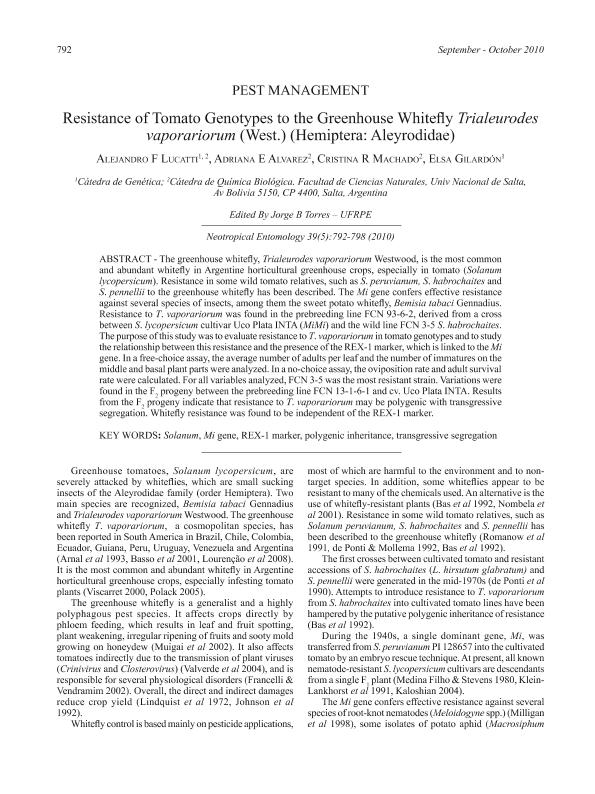Mostrar el registro sencillo del ítem
dc.contributor.author
Lucatti, Alejandro Francisco

dc.contributor.author
Alvarez, Adriana Elisabet
dc.contributor.author
Machado Assefh, Cristina Renata

dc.contributor.author
Gilardón, Elsa
dc.date.available
2017-03-20T20:46:46Z
dc.date.issued
2010-09
dc.identifier.citation
Lucatti, Alejandro Francisco; Alvarez, Adriana Elisabet; Machado Assefh, Cristina Renata; Gilardón, Elsa; Resistance of tomato genotypes to the greenhouse Whitefly Trialeurodes vaporariorum (West.) (Hemiptera: Aleyrodidae); Sociedade Entomológica Do Brasil; Neotropical Entomology; 39; 5; 9-2010; 792-798
dc.identifier.issn
1519-566X
dc.identifier.uri
http://hdl.handle.net/11336/14121
dc.description.abstract
The greenhouse whitefly, Trialeurodes vaporariorum Westwood, is the most common and abundant whitefly in Argentine horticultural greenhouse crops, especially in tomato (Solanum lycopersicum). Resistance in some wild tomato relatives, such as S. peruvianum, S. habrochaites and S. pennellii to the greenhouse whitefly has been described. The Mi gene confers effective resistance against several species of insects, among them the sweet potato whitefly, Bemisia tabaci Gennadius. Resistance to T. vaporariorum was found in the prebreeding line FCN 93-6-2, derived from a cross between S. lycopersicum cultivar Uco Plata INTA (MiMi) and the wild line FCN 3-5 S. habrochaites. The purpose of this study was to evaluate resistance to T. vaporariorum in tomato genotypes and to study the relationship between this resistance and the presence of the REX-1 marker, which is linked to the Mi gene. In a free-choice assay, the average number of adults per leaf and the number of immatures on the middle and basal plant parts were analyzed. In a no-choice assay, the oviposition rate and adult survival rate were calculated. For all variables analyzed, FCN 3-5 was the most resistant strain. Variations were found in the F2 progeny between the prebreeding line FCN 13-1-6-1 and cv. Uco Plata INTA. Results from the F2 progeny indicate that resistance to T. vaporariorum may be polygenic with transgressive segregation. Whitefly resistance was found to be independent of the REX-1 marker.
dc.format
application/pdf
dc.language.iso
eng
dc.publisher
Sociedade Entomológica Do Brasil

dc.rights
info:eu-repo/semantics/openAccess
dc.rights.uri
https://creativecommons.org/licenses/by-nc-sa/2.5/ar/
dc.subject
Solanum
dc.subject
Mi-Gene
dc.subject
Rex-1 Marker
dc.subject
Polygenic Inheritance
dc.subject
Transgressive Segregation
dc.subject.classification
Genética y Herencia

dc.subject.classification
Ciencias Biológicas

dc.subject.classification
CIENCIAS NATURALES Y EXACTAS

dc.subject.classification
Agronomía, reproducción y protección de plantas

dc.subject.classification
Agricultura, Silvicultura y Pesca

dc.subject.classification
CIENCIAS AGRÍCOLAS

dc.title
Resistance of tomato genotypes to the greenhouse Whitefly Trialeurodes vaporariorum (West.) (Hemiptera: Aleyrodidae)
dc.type
info:eu-repo/semantics/article
dc.type
info:ar-repo/semantics/artículo
dc.type
info:eu-repo/semantics/publishedVersion
dc.date.updated
2017-03-20T14:52:30Z
dc.identifier.eissn
1678-8052
dc.journal.volume
39
dc.journal.number
5
dc.journal.pagination
792-798
dc.journal.pais
Brasil

dc.journal.ciudad
Santo Antônio de Goiás
dc.description.fil
Fil: Lucatti, Alejandro Francisco. Universidad Nacional de Salta; Argentina. Consejo Nacional de Investigaciones Científicas y Técnicas; Argentina
dc.description.fil
Fil: Alvarez, Adriana Elisabet. Universidad Nacional de Salta. Facultad de Cs.naturales. Escuela de Biologia. Catedra de Quimica Biologica; Argentina
dc.description.fil
Fil: Machado Assefh, Cristina Renata. Universidad Nacional de Salta. Facultad de Cs.naturales. Escuela de Biologia. Catedra de Quimica Biologica; Argentina. Consejo Nacional de Investigaciones Científicas y Técnicas; Argentina
dc.description.fil
Fil: Gilardón, Elsa. Universidad Nacional de Salta; Argentina
dc.journal.title
Neotropical Entomology

dc.relation.alternativeid
info:eu-repo/semantics/altIdentifier/url/http://dx.doi.org/10.1590/S1519-566X2010000500019
dc.relation.alternativeid
info:eu-repo/semantics/altIdentifier/url/http://ref.scielo.org/s646yf
Archivos asociados
